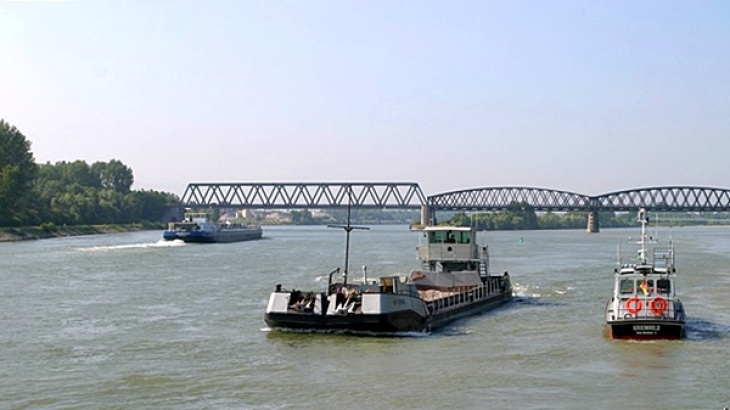The project “Bed load dynamics and grain size development in the free-flowing Upper Rhine” investigates the granulometric and morphologic development of the river bed in combination with investigations of bed load transport dynamics in the upstream section of the Middle Rhine Supersite, just downstream of Iffezheim barrage. The focus of the investigations is on the performance control of continuous artificial bed load nourishment conducted by the Federal Waterways and Shipping Authority to ensure a balanced sediment budget in the free-flowing Upper Rhine.
Motivation

Bed load nourishment using split hopper barges (Photo: Federal Waterways Engineering and Research Institute)
Artificial bed load nourishment at Iffezheim barrage is being conducted since 1978 and contributes to sustaining the river bed downstream of the barrage and to the preservation of its dynamic balance. Continued performance control of these measures is of fundamental importance for the morphology of the river bed and consequently for ecology and shipping along the river. Particularly relevant is the assessment of bed stability and the dispersal of bed material in order to prevent undesirable erosion or deposition and to assess the suitability of the supplied bed material.
Methods

Sampling of bed material using the diving bell ship “Carl Straat” (Photo: Federal Waterways Engineering and Research Institute)
Periodical echo-soundings along the Upper Rhine provide insights into medium- and large-scale morphological changes and can be used to assess changes of bed load volumetric budgets over time and in different river sections. Complementing, bed load samplers provide regular direct bed load measurements in several places along the Upper Rhine. Together with discharge measurements, these allow for estimations of total transported bed load amounts.
Sampling of bed material from the topmost layers of the river bed provides additional insights into bed development. For this, samples are collected from two depths of multiple cross sections with time intervals of several years. The granulometric analysis of these samples provides continuous documentation and allows for the assessment of changes in grain composition throughout the river reach due to bed load nourishment, for example.
Additional insights into transport and dispersal can be gained using bed load tracers. In particular, transport distance and velocity during specific hydraulic conditions can be investigated.
The project is conducted in cooperation with the Wasserstraßen- und Schifffahrtsamt Oberrhein
The project profile of Bed Load Dynamics investigations at the Upper Rhine as a flyer in pdf format:
Project Profile Bed Load Dynamics Upper Rhine (2,7 MB)

